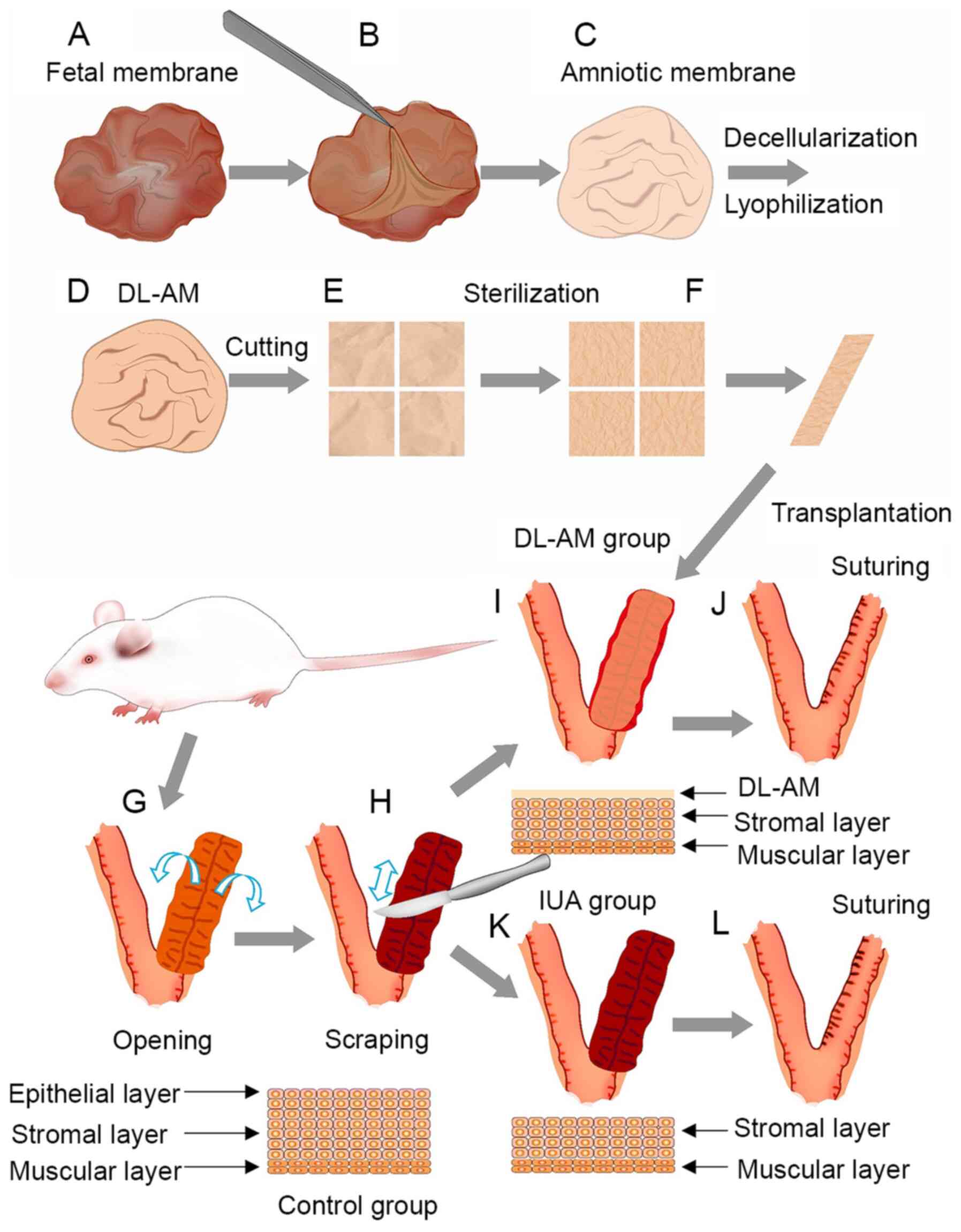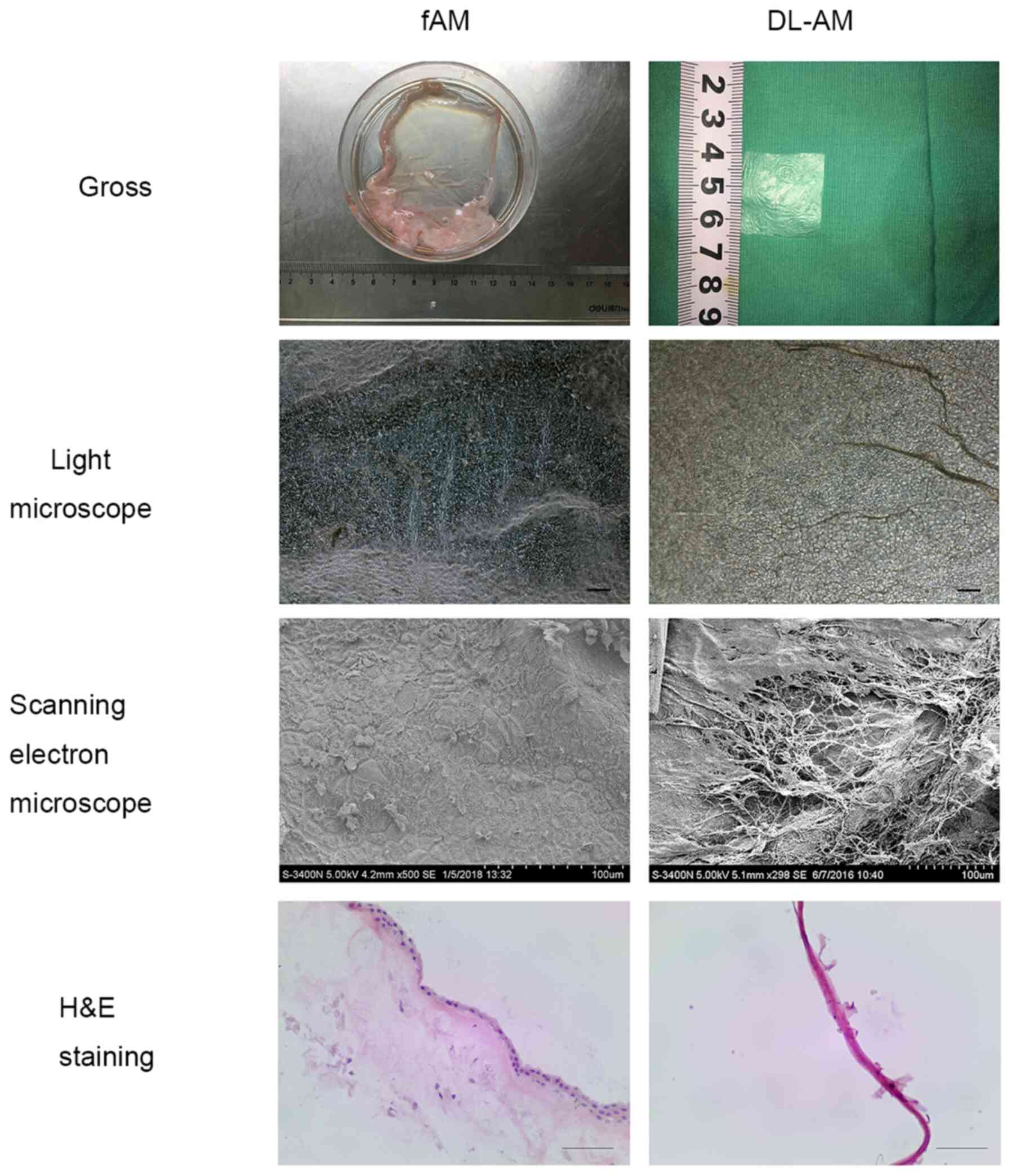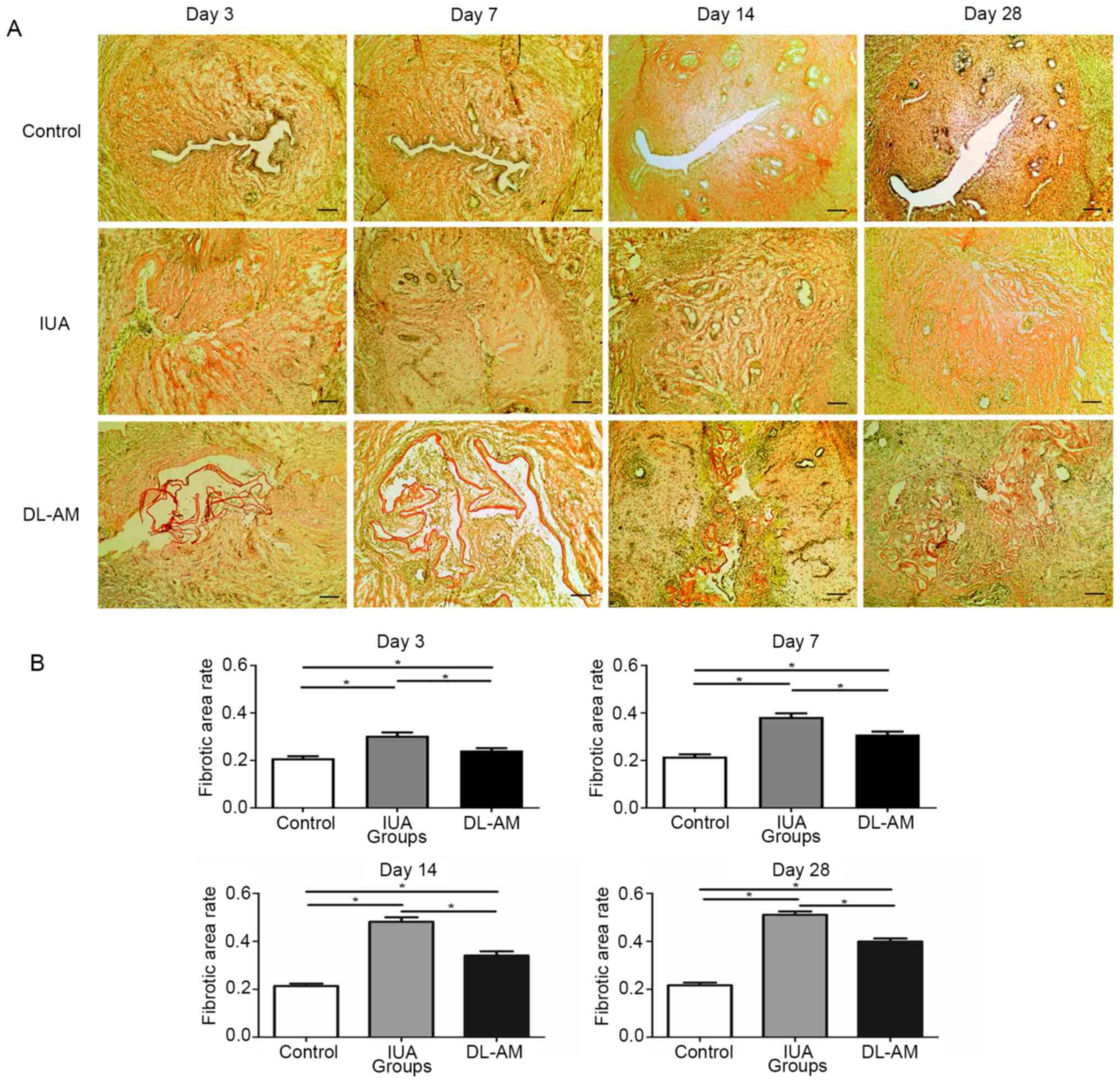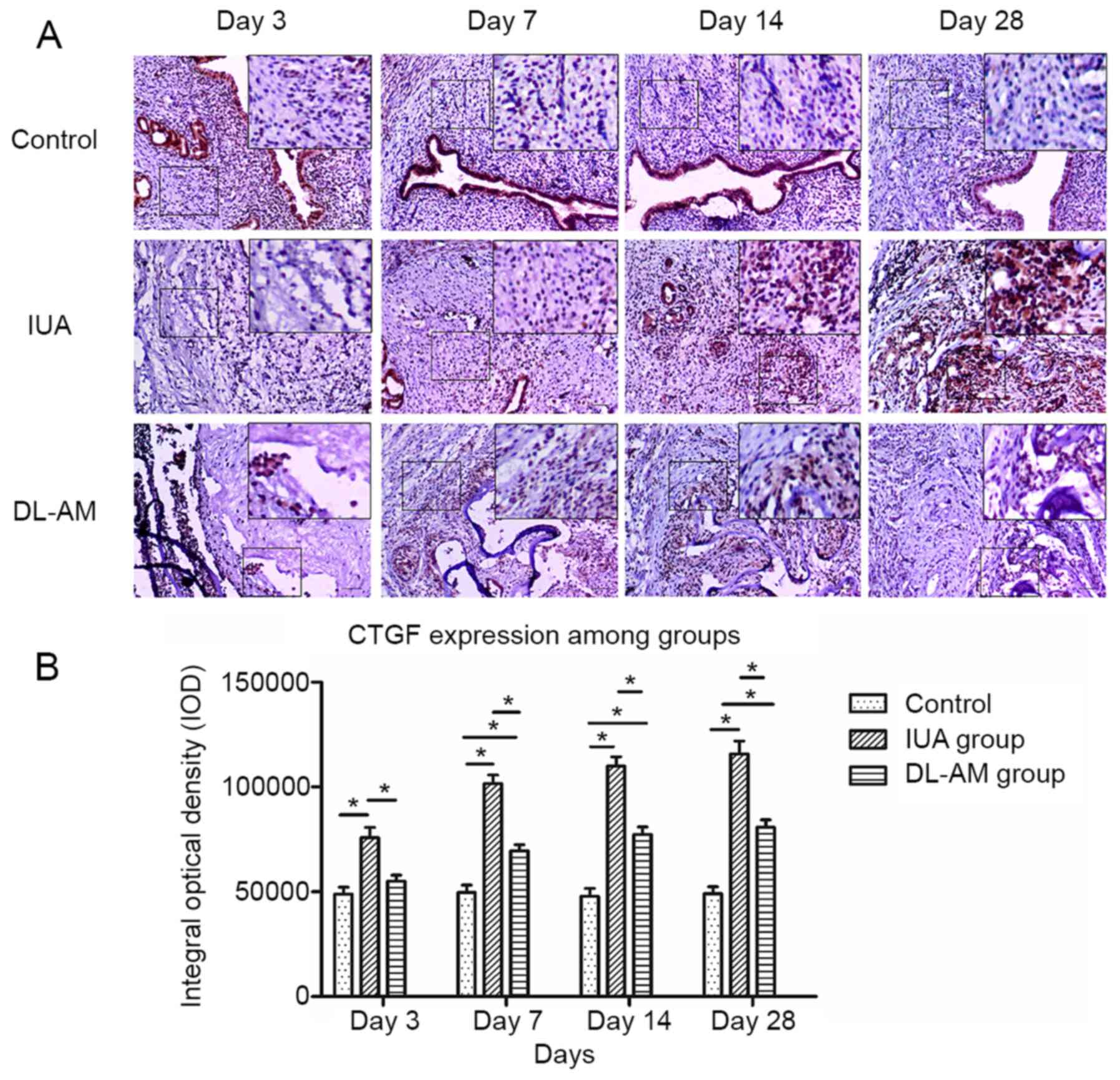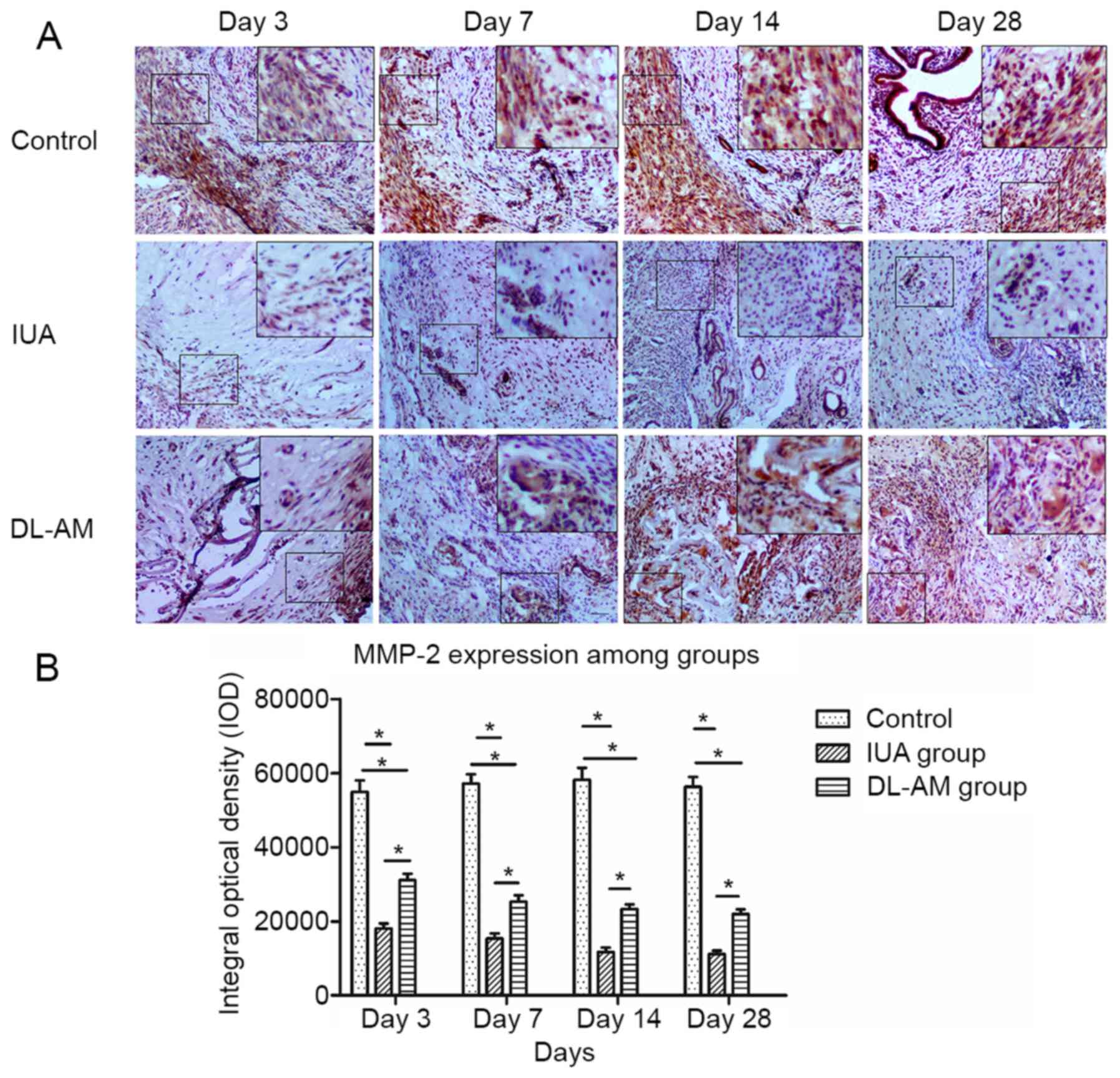|
1
|
Yu D, Wong YM, Cheong Y, Xia E and Li TC:
Asherman syndrome-one century later. Fertil Steril. 89:759–779.
2008.PubMed/NCBI View Article : Google Scholar
|
|
2
|
Westendorp IC, Ankum WM, Mol BW and Vonk
J: Prevalence of Asherman's syndrome after secondary removal of
placental remnants or a repeat curettage for incomplete abortion.
Hum Reprod. 13:3347–3350. 1998.PubMed/NCBI View Article : Google Scholar
|
|
3
|
Vancaillie TG and Garad R: Asherman's
syndrome. Aust Nurs J. 20:34–36. 2013.PubMed/NCBI
|
|
4
|
Conforti A, Alviggi C, Mollo A, De Placido
G and Magos A: The management of Asherman syndrome: A review of
literature. Reprod Biol Endocrinol. 11(118)2013.PubMed/NCBI View Article : Google Scholar
|
|
5
|
Fairbairn NG, Randolph MA and Redmond RW:
The clinical applications of human amnion in plastic surgery. J
Plast Reconstr Aesthet Surg. 67:662–675. 2014.PubMed/NCBI View Article : Google Scholar
|
|
6
|
Dua HS, Gomes JAP, King AJ and Maharajan
VS: The amniotic membrane in ophthalmology. Surv Ophthalmol.
49:51–77. 2004.PubMed/NCBI View Article : Google Scholar
|
|
7
|
Fraser JF, Cuttle L, Kempf M, Phillips GE,
Hayes MT and Kimble RM: A randomised controlled trial of amniotic
membrane in the treatment of a standardised burn injury in the
merino lamb. Burns. 35:998–1003. 2009.PubMed/NCBI View Article : Google Scholar
|
|
8
|
Gholipourmalekabadi M, Sameni M,
Radenkovic D, Mozafari M, Mossahebi-Mohammadi M and Seifalian A:
Decellularized human amniotic membrane: How viable is it as a
delivery system for human adipose tissue-derived stromal cells?
Cell Prolif. 49:115–121. 2016.PubMed/NCBI View Article : Google Scholar
|
|
9
|
Wilshaw SP, Kearney JN, Fisher J and
Ingham E: Production of an acellular amniotic membrane matrix for
use in tissue engineering. Tissue Eng. 12:2117–2129.
2006.PubMed/NCBI View Article : Google Scholar
|
|
10
|
Kakabadze Z, Mardaleishvili K, Loladze G,
Javakhishvili I, Chakhunasvili K, Karalashvili L, Sukhitashvili N,
Chutkerashvili G, Kakabadze A and Chakhunasvili D: Clinical
application of decellularized and lyophilized human amnion/chorion
membrane grafts for closing post-laryngectomy pharyngocutaneous
fistulas. J Surg Oncol. 113:538–543. 2016.PubMed/NCBI View Article : Google Scholar
|
|
11
|
Chen X, Sun J, Li X, Mao L, Cui L and Bai
W: Transplantation of oral mucosal epithelial cells seeded on
decellularized and lyophilized amniotic membrane for the
regeneration of injured endometrium. Stem Cell Res Ther.
10(107)2019.PubMed/NCBI View Article : Google Scholar
|
|
12
|
Chen X, Sun J, Li X, Mao L, Zhou Y, Cui L
and Bai W: Antifibrotic effects of decellularized and lyophilized
human amniotic membrane transplant on the formation of intrauterine
adhesion. Exp Clin Transplant. 17:236–242. 2019.PubMed/NCBI View Article : Google Scholar
|
|
13
|
Chen X and Zhou YF: Preventive effects of
transplantation of oral mucosal epithelial cells seeded on a
decellularized amniotic membrane in a model of intrauterine
adhesion. Int J Clin Exp Pathol. 11:1510–1519. 2018.PubMed/NCBI
|
|
14
|
Xue X, Chen Q, Zhao G, Zhao JY, Duan Z and
Zheng PS: The overexpression of TGF-β and CCN2 in intrauterine
adhesions involves the NF-κB signaling pathway. PLoS One.
10(e0146159)2015.PubMed/NCBI View Article : Google Scholar
|
|
15
|
Visse R and Nagase H: Matrix
metalloproteinases and tissue inhibitors of metalloproteinases:
Structure, function, and biochemistry. Circ Res. 92:827–839.
2003.PubMed/NCBI View Article : Google Scholar
|
|
16
|
Percie du Sert N, Hurst V, Ahluwalia A,
Alam S, Avey MT, Baker M, Browne WJ, Clark A, Cuthill IC, Dirnagl
U, et al: The ARRIVE guidelines 2.0: Updated guidelines for
reporting animal research. J Physiol. 598:3793–3801.
2020.PubMed/NCBI View Article : Google Scholar
|
|
17
|
Fan B, Jin XH, Shi Y, Zhu H, Zhou W, Tu W
and Ding L: Expression and significance of TIMP-3, PACAP and VIP in
vaginal wall tissues of patients with stress urinary incontinence.
Exp Ther Med. 13:624–628. 2017.PubMed/NCBI View Article : Google Scholar
|
|
18
|
Yu J, Luo Y, Yang XF, Yang MX, Yang J,
Yang XS, Zhou J, Gao F, He LT and Xu J: Effects of perinatal
exposure to nonylphenol on delivery outcomes of pregnant rats and
inflammatory hepatic injury in newborn rats. Braz J Med Biol Res.
49(e5647)2016.PubMed/NCBI View Article : Google Scholar
|
|
19
|
Chávez-García C, Jiménez-Corona A,
Graue-Hernández EO, Zaga-Clavellina V, García-Mejía M,
Jiménez-Martínez MC and Garfias Y: Ophthalmic indications of
amniotic membrane transplantation in Mexico: An eight years
amniotic membrane bank experience. Cell Tissue Bank. 17:261–268.
2016.PubMed/NCBI View Article : Google Scholar
|
|
20
|
Koizumi N, Rigby H, Fullwood NJ, Kawasaki
S, Tanioka H, Koizumi K, Kociok N, Joussen AM and Kinoshita S:
Comparison of intact and denuded amniotic membrane as a substrate
for cell-suspension culture of human limbal epithelial cells.
Graefes Arch Clin Exp Ophthalmol. 245:123–134. 2007.PubMed/NCBI View Article : Google Scholar
|
|
21
|
Francisco JC, Correa Cunha R, Cardoso MA,
Baggio Simeoni R, Mogharbel BF, Picharski GL, Silva Moreira
Dziedzic D, Guarita-Souza LC and Carvalho KA: Decellularized
amniotic membrane scaffold as a pericardial substitute: An in vivo
study. Transplant Proc. 48:2845–2849. 2016.PubMed/NCBI View Article : Google Scholar
|
|
22
|
Roy R, Haase T, Ma N, Bader A, Becker M,
Seifert M, Choi YH, Falk V and Stamm C: Decellularized amniotic
membrane attenuates postinfarct left ventricular remodeling. J Surg
Res. 200:409–419. 2016.PubMed/NCBI View Article : Google Scholar
|
|
23
|
Lian N and Li T: Growth factor pathways in
hypertrophic scars: Molecular pathoenesis and therapeutic
implications. Biomed Pharmacother. 84:42–50. 2016.PubMed/NCBI View Article : Google Scholar
|
|
24
|
He T, Quan T, Shao Y, Voorhees JJ and
Fisher GJ: Oxidative exposure impairs TGF-β pathway via reduction
of type II receptor and SMAD3 in human skin fibroblasts. Age
(Dordr). 36(9623)2014.PubMed/NCBI View Article : Google Scholar
|
|
25
|
Sharma A, Thakur R, Lingaraju MC and Kumar
D, Mathesh K, Telang AG, Singh TU and Kumar D: Betulinic acid
attenuates renal fibrosis in rat chronic kidney disease model.
Biomed Pharmacother. 89:796–804. 2017.PubMed/NCBI View Article : Google Scholar
|
|
26
|
Paradis V, Dargere D, Vidaud M, De
Gouville AC, Huet S, Martinez V, Gauthier JM, Ba N, Sobesky R,
Ratziu V and Bedossa P: Expression of connective tissue growth
factor in experimental rat and human liver fibrosis. Hepatology.
30:968–976. 1999.PubMed/NCBI View Article : Google Scholar
|
|
27
|
Sgalla G, Franciosa C, Simonetti J and
Richeldi L: Pamrevlumab for the treatment of idiopathic pulmonary
fibrosis. Expert Opin Investig Drugs. 29:771–777. 2020.PubMed/NCBI View Article : Google Scholar
|
|
28
|
Hafez MM, Hamed SS, El-Khadragy MF, Hassan
ZK, Al Rejaie SS, Sayed-Ahmed MM, Al-Harbi NO, Al-Hosaini KA,
Al-Harbi MM, Alhoshani AR, et al: Effect of ginseng extract on the
TGF-β1 signaling pathway in CCl4-induced liver fibrosis
in rats. BMC Complement Altern Med. 17(45)2017.PubMed/NCBI View Article : Google Scholar
|
|
29
|
Knittel T, Mehde M, Grundmann A, Saile B,
Scharf JG and Ramadori G: Expression of matrix metalloproteinases
and their inhibitors during hepatic tissue repair in the rat.
Histochem Cell Biol. 113:443–453. 2000.PubMed/NCBI View Article : Google Scholar
|
|
30
|
Guan S, Liu Q, Han F, Gu W, Song L, Zhang
Y, Guo X and Xu W: Ginsenoside Rg1 ameliorates cigarette
smoke-induced airway fibrosis by suppressing the TGF-β1/Smad
pathway in vivo and in vitro. Biomed Res Int.
2017(6510198)2017.PubMed/NCBI View Article : Google Scholar
|
|
31
|
Zhang M, Hu X, Li S, Lu C, Li J, Zong Y,
Qi W and Yang H: Hepatoprotective effects of ethyl pyruvate against
CCl4-induced hepatic fibrosis via inhibition of TLR4/NF-κB
signaling and up-regulation of MMPs/TIMPs ratio. Clin Res Hepatol
Gastroenterol. 42:72–81. 2018.PubMed/NCBI View Article : Google Scholar
|
|
32
|
Zuo WL, Zhao JM, Huang JX, Zhou W, Lei ZH,
Huang YM, Huang YF and Li HG: Effect of bosentan is correlated with
MMP-9/TIMP-1 ratio in bleomycin-induced pulmonary fibrosis. Biomed
Rep. 6:201–205. 2017.PubMed/NCBI View Article : Google Scholar
|
|
33
|
Zhao D, Wang Y, Du C, Shan S, Zhang Y, Du
Z and Han D: Honokiol alleviates hypertrophic scar by targeting
transforming growth factor-β/Smad2/3 signaling pathway. Front
Pharmacol. 8(206)2017.PubMed/NCBI View Article : Google Scholar
|















